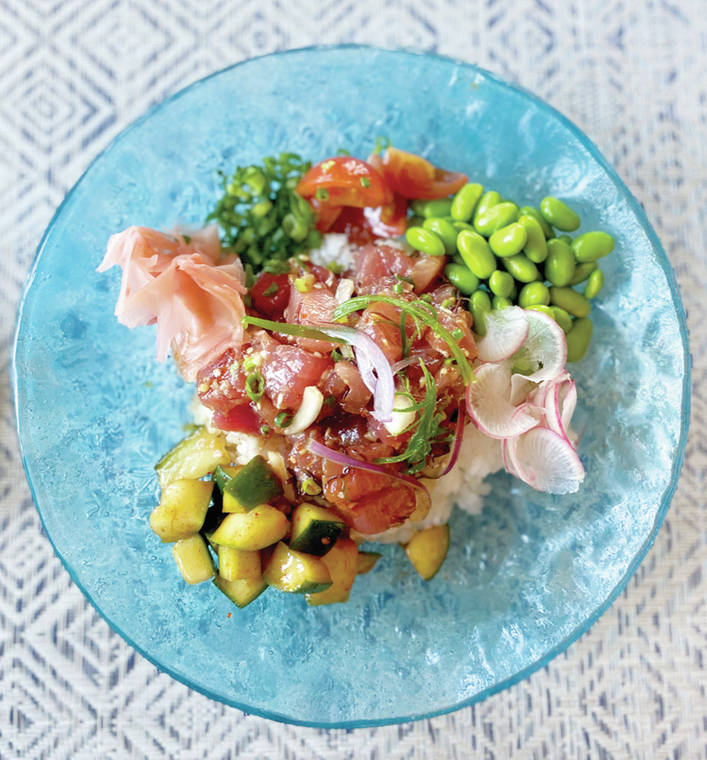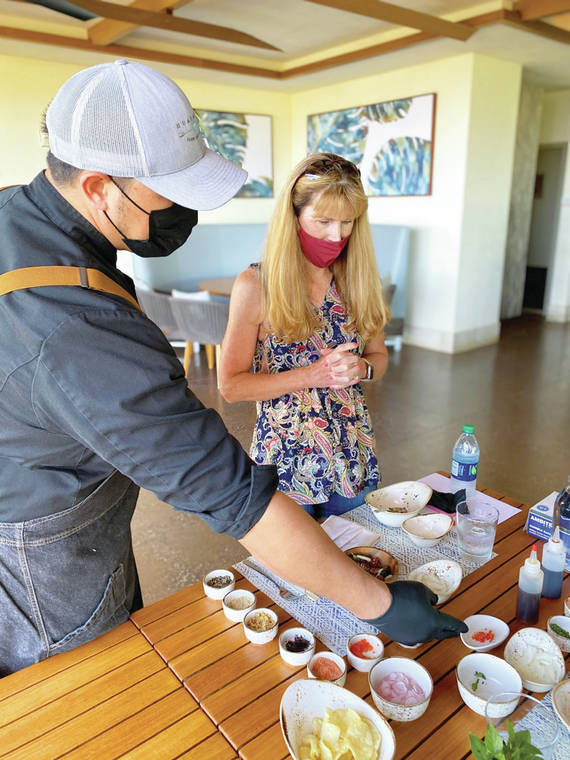Hualani’s master chef Zach Cummings at Timbers of Kaua‘i knows the cultural significance of poke during the holiday season.
Cummings, who began teaching poke master classes in December of 2018 at Timbers Kaua‘i, has chosen to offer some of his expertise and advice on how people can enhance their poke during the holiday season.
“(At home) you can incorporate a festive, light, holiday drink such as a mulled cider or local mead from Nani Moon Meadery,” Cummings said. “Put on that red Santa hat and start serving. During the holidays, I am always cooking with the aloha and holiday spirit.”
Fresh catch
When eating poke, Cummings said eating it fresh is the best approach.
“Fresh is always the way to go,” Cummings said. “If you can’t catch the fish or seafood yourself, the next best alternative is to support your local small business poke shops and fish markets such as Leong’s Market, Koloa Fish Market, Konohiki and the Kilauea market.”
Preparing poke also provides an advantage when you are a local fisherman or know a local fisherman, Cummings said.
“If you know local fisherman, like the Uprise Farms Seafood coalition, getting a fresh catch right off the boat is the way to go,” Cummings said.
A poke platter
There are multiple ways to construct a poke platter, which features several options of styles and flavors.
Cummings stated some examples include classic ahi shoyu sesame poke, tako (cooked, sliced octopus) poke, kimchee shrimp poke, hamachi limu poke, and dynamite style poke (siracha-mayo with lemon and tobiko mixed with any seafood).
There are also vegan options such as edamame soybean poke, tofu poke and kimchee cucumber poke.
Other creative dishes include deep fried wonton wrappers, and poke tostadas with fresh avocado and drizzled with wasabi aioli.
Cummings said you can also try poke musubi by building a traditional musubi in your sushi maker, switch out the spam and dip it in a mixture of wasabi soy.
Lots of options to choose from
Having options gives you several different varieties, especially when you are entertaining guests during the holidays.
One option Cummings said consumers have is enjoying your sushi rice or favorite chip poke nacho-style.
“Poi is always going to be my favorite, and home-made Hawaiian chili-pepper water is a must,” Cummings said. “I love to add fresh, thinly shaved radishes to give it a fresh, spicy pop.
Another approach to poke is to mix your fresh, diced fish with coconut milk, Tahitian lime, diced onions, diced tomatoes and diced cucumber, and turn it into a Tahitian style poisson crul with fresh ono to make it the best.
A Christmas tradition
Before Hawai‘i had contact with the western world, the Hawaiians mixed their fresh-caught fish with pa‘a kai (sea salt), different varieties of limu (seaweed) and crushed inamona (kukui nut).
When ships began to arrive from the Western world, sailors started to trade salmon with the natives.
That is when the Hawai’ians started to incorporate it into their food traditions, resulting in dishes like lomi salmon.
When immigrants arrived from Asia, they brought with them soy sauce and sesame oil.
The basic definition of poke literally means to “slice” or “cut crosswise into pieces.”
The fish used in poke was essentially the cut-offs from their catch to serve as a pupu (appetizer or snack), as opposed to the high-quality ahi (a popular choice) prevalent in most poke recipes today, according to Cummings.
Hawai’ian-style poke was inspired by the evolution of family traditions and best shared with family and friends.
“Poke is a fun dish that you can enjoy with your own personal preferences, using raw or even cooked seafood and meats,” Cummings said.
•••
Jason Blasco, reporter, can be reached at 245-0437 or jblasco@thegardenisland.com.




